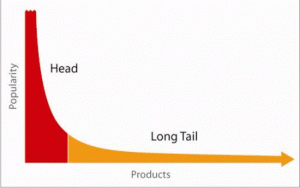Archive for December 6th, 2011
Globalisation and The Long Tail no comments
Globalisation refers to the how the world is ‘shrinking’ culturally and economically. How the world is changing from different nations managing themselves to one big world trading ideas, people, products and money. There are many global companies such as MacDonalds that exists everywhere! There are a number of advantages and disadvantages to globalisation. Sometimes it can be seen as a good thing that benefits small businesses by giving them access to a larger market, such as through the Internet. However, sometimes it can also be seen as a bad thing, for example with the outsourcing of work to poorer countries and buying materials for production in poorer countries to save money which can affect the local and national economy.
The Long Tail – Chris Anderson
The tail refers to the long end of the curve on the graph that depicts the popularity of all products. As you can see from the image above, ‘the head’ is short and contains the most popular of products. These are things that everyone wants, think of it is the top 40 songs in the charts. ‘The tail’ is much longer and consists of every other product in existence (or every song that is not in the top 40!). These things are much less popular, but there is a lot more of them. Money can be made by just selling products from the long tails, you would sell maybe one of each product rather than millions of one product as is seen in ‘the head’.
Companies do still aim for a business model that targets ‘the head’ rather than the long tail. For example radio stations tend to play the popular music at that moment in time, but there is a suggestion from Chris Anderson that the radio is dead.
Why the radio is dead:
- Radio stations need money so they need advertising and therefore need listeners. To get the most listeners you need to appeal to the majority who like what is popular at that moment in time (‘the head’).
- The rise of technology in the form of MP3 players. You can listen to any music you want at home, on your PC, on my personal MP3 player and even take that into your car and connect it to a modern car stereo.
Chris Anderson also suggests that “The Long Tail is full of crap.” Which is it…It does contain everything! But the compelling thing about the long tail is that there is something for everybody that they would not be able to find and purchase otherwise.
The Internet and the Long Tail
The internet has given us unprecedented ability to access products never before available so quickly and easily. The Internet is the best example of how globalisation can reach everyone. Someone who makes Doggles (goggles for dogs), or other niche items, can become a millionaire.

A real shop on the high street may have trouble making money if it was taking advantage of the long tail. Not just for the reason that it cannot reach as many customers as an online shop, but for more practical reasons that it would be difficult to sort through all of the many niche products. Being able to search through the ‘crap’ and filter to get to the information you actually want is very much a benefit you can see online. Social media may also help with this, we often see suggestions for other items we might like on online shops like Amazon. Folksonomies consisting of lots of tags collaboratively created may also assist with finding things you want and things that are similar to it.
Does the Internet bring down the barriers for businesses?
Is Globalisation good for the small business?
Yes and no, it depends on what you are selling. There is the potential for more sales through having greater access to a wider market. This is especially true for niche items and products where in some situations they may sell nothing if they are not based near their market. The Internet definitely assists with globalisation based on geography. There is also the benefit that selling products online is very cheap to set up and use. Google Analytics is also a nice tool to assist with marketing and improving your own business website.
However, with the benefits of reaching more people, large businesses will also receive this benefit. Large businesses may be able to give better prices due to mass production, but this shouldn’t effect niche businesses where large businesses do not offer so many niche products.
E-business (concluding thoughts – part 1 of 2) no comments
Picking up from where I left off last week – I want to shift the focus firmly onto the impact of the Web/Internet on business competition as I move on from broad principles of management/economics to specifics. The examples used below are taken from Boddy’s ‘Management, An Introduction’.
I kick off with a consideration of Google as an illustration of the impact that the Web/Internet has had on competition between businesses. Google exemplifies a company created to use the Web/Internet – it is a pure e-business company built entirely around information technology. Since the search engine serve is free, it generates revenues by providing advertisers with the opportunity to deliver online advertising that is relevant to search results on a page. The advertisements are displayed as sponsored links, with the message appearing alongside search results for appropriate keywords. They are priced on a cost-per-impression basis, whereby advertisers pay a fixed amount each time their ad is viewed. The charge depends on what the advertiser has bid for the keywords, and the more they bid the nearer the top of the page their advertisement will be. Google has rapidly expanded the range of services it offers.
Pure e-businesses such as Google which focuses on search processes (other examples include easyGroup which exclusively sells its services online and eBay which facilitates online transactions) can be contrasted with companies existing before the Web/Internet but which use it to support many of their activities. They may still perform the same functions, but the Web/Internet often enables them to offer new services through an additional distribution channel online (such as banks).
As well as offering new ways of doing business, the Web/Internet also affects the way services are created and delivered. Examples include: delivering media content; satellite freight tracking services; and, social networking sites. Picking up on this last example in particular, social networking sites (types of community systems) enabling people to exchange information have grown very quickly. Setting up blogs is one major use, as are websites through which people with particular interests exchange information. They are significant for businesses even if they extend beyond the firm, since customers can use them to exchange positive or negative information about the company. These applications affect the strategy and competiveness of organization.
The publishing industry (compare music, film and journalism) is an example of a business model founded on information (its gathering, processing and dissemination) for whom the Web is the biggest threat. As digitisation and the Web have reduced the cost of the dissemination of information, it undermines the value proposition of those industries built on its premise.
There is also an internal business impact of the Web in terms of changing various aspects of organisational activity. Common information systems based on the Web/Internet move information between organizations, often having direct links with customers. This is part of a broader assessment of how information technology, in general, is affecting the way that business is carried out.
One way to consider the impact of the Web/Internet on business is by geographic reach. Inter-organisational information systems link organisations electronically by using networks that transcend company boundaries. They enable firms to incorporate buyers, suppliers and partners in the redesign of their key business processes, thereby enhancing productivity, quality, speed and flexibility. New distribution channels can be created and new information-based products and services can be delivered. In addition, many information systems radically alter the balance of power in buyer-supplier relationships, raise barriers to entry and exit and, in many instances, shift the competitive position of industry participants.
From an alternative perspective as an information system, the Web/Internet has had wide effects on managing data, information and knowledge. It can, for example, be used to integrate processes, from suppliers through to customer delivery. Managers must ensure that their organisation makes profitable use of the possibilities that the Web/Internet offers in a way that suits their particular business; and, not just as a technology challenge, but also as a ‘people challenge’. For example, network systems help people to communicate and interact with each other, but they do not define how they should do so (such as who should gain access to which part of the system or who is responsible for responding to customer comments on a blog – these are matters to be implemented and modified in the light of experience).
A useful distinction can be made between intranets and extranets. The former is a private computer network operating within an organisation, using Web/Internet standards and protocols and security protected. An extranet is a closed, collaborative network that uses the Web/Internet to link businesses with specified suppliers, customers or other trading partners. It can be linked to business intranets where information is accessible through a password system.
The simplest Web/Internet applications provide information, enabling customers to view products or other information on a company website; conversely, suppliers use their website to show customers what they can offer. Web/Internet marketplaces are developing in which groups of suppliers in the same industry operate a collective website, making it easier for potential customers to compare terms through a single portal. The next stage is to use the Web/Internet for interaction. Customers enter information and questions about, say, offers and prices. The system then uses the customer information, such as preferred dates and times of travel, to show availability and costs.
Another use is for transactions, when customers buy goods and services through a supplier’s website. Conversely a supplier who sees a purchasing requirement from a business (perhaps expressed as a purchase order on the website) can agree electronically to meet the order. The whole transaction, from accessing information through ordering, delivery and payment, can take place electronically.
Finally, a company achieves integration when it links its own information system to customers and suppliers: it becomes an e-business. Dell Computing is an example. Other companies use the Web/Internet to create and orchestrate active customer communications (e.g. Kraft, Intel and Apple). These communications enable companies to become closer to their customers and to learn how best to improve a product/service much more quickly than is possible through conventional market research techniques.
In conclusion, the Web/Internet is radically challenging many established ways of doing business. Combined with political change, this is creating a wider, often global, market for many goods and services.
Next week, in my final post, I will round up on the topics of e-commerce and e-business and the associated challenges faced by businesses in managing innovation and change.
